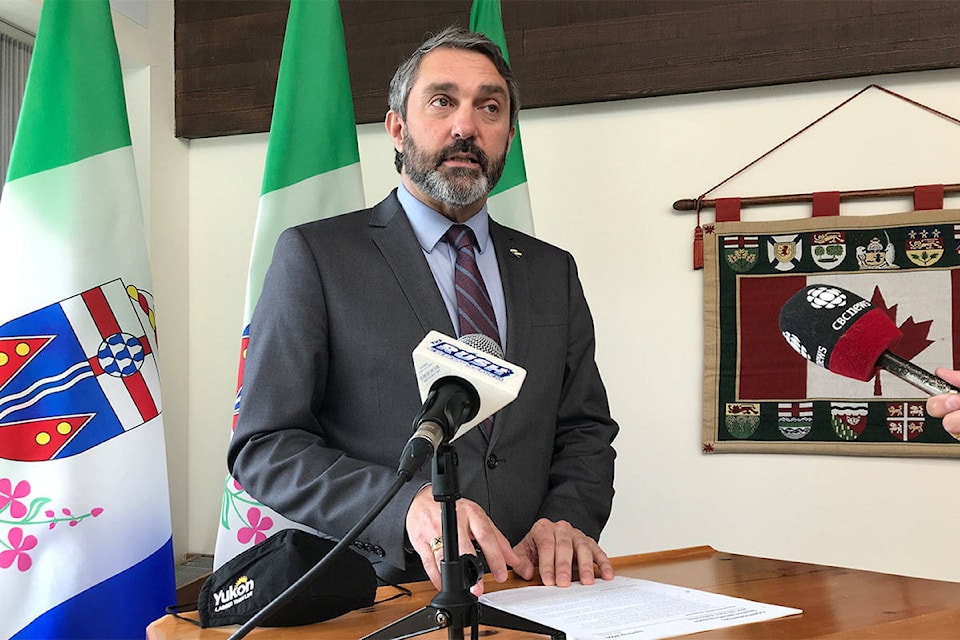Premier Sandy Silver has sent out the blueprint of government priorities to his ministers this week, with seven mandate letters that outline the goals of each department.
“As we enter our second mandate, we are building on a solid foundation to move the Yukon forward, working with the people of the territory to make their lives better,” opens the boilerplate introduction on each of the letters, which are addressed from the premier to ministers.
Compared to the 2019 mandate letters, this year’s broad strokes highlight COVID-19 recovery, relationships with Yukon First Nations and the federal government and two guiding government reports: the climate change strategy in Our Clean Future and healthcare reform in Putting People First.
The previous mandate letters, sent out before the pandemic in 2019, focused on the Yukon economy, climate change and First Nations relations. There was also an emphasis on the “one government approach” and relationships across the entire territory.
Highlights of priorities
Tracy-Anne McPhee, Ranj Pillai and John Streicker have the longest mandate letters at five pages each for the Health, Economic Development, and Energy, Mines and Resources portfolios. The other documents wrap up at four pages.
Much of the content involves campaign promises — including a new fieldhouse, varsity teams at Yukon University and the creation of McIntyre Creek Park.
Health Minister Tracy-Anne McPhee will be taking the lead on implementing the many recommendations within the Putting People First report, which includes items as diverse as a new on-the-land substance treatment centre, payment of physicians, a francophone health centre and subsidized fertility treatments.
Big items that require input from multiple ministers include the implementation of Our Clean Future, completion of the Dawson Land Use Plan and updated mining legislation.
Ranj Pillai’s mandate letter includes tackling the housing crisis, in addition to tourism recovery, a new fund for Junior Mining expiration, e-commerce for private cannabis retailers and “working with partners and stakeholders to investigate the feasibility of commercial and passenger rail in the Yukon.”
John Streicker’s mandate letter also notes that new collective agreements will need to be negotiated with the Yukon Teachers Association and the Yukon Employees Union.
The premier’s mandate letter also includes a review of the COVID-19 response when the state of emergency eventually ends. The Department of Community Services and the Department of Health and Social Services have been tasked to “review the Civil Emergency Measures Act [CEMA] and the Public Health and Safety Act.”
Opposition response
Yukon Party leader Currie Dixon said in addition to being rolled out three months after the election of the government, the mandate letters contain too many previous commitments rolled over.
“There’s stuff in there that’s pretty generic,” he said. “When you give direction, like, ‘Work on shared priorities with the federal government,’ that’s pretty nonspecific and pretty useless to anybody who wants to go implement that.”
“A lot of the items that are committed to in these mandate letters are just simply unfulfilled promises from the last mandate,” he said.
There is some overlap between the previous round of letters. Items including midwifery integration, the Dempster Fibre project and advancing the Yukon Resource Gateway were also present in the 2019 mandate letters.
Dixon said he is concerned that a review of COVID-19 would be led by the premier.
“I think that’s obviously inappropriate. I mean, that’s very much like writing your own report card,” he said.
NDP MLA Emily Tredger said her party would also seek to be involved in any review of CEMA.
Overall, she said the mandate letters included many big items that the NDP were happy with. Others — such as the housing shortage and the opioid crisis — should have received more attention.
“There were lots of good things that we were happy to see and there were a couple gaps that I hope get addressed,” said Tredger.
“As far as I can tell from reading it, there’s no mandate to increase the number of Yukon housing units and with 350 people on the waitlist that’s not going to go away unless we increase the number of units,” she said. “Another big gap I saw was there wasn’t any talk about responding to the opioid epidemic or the overdoses.”
“I’m very happy to see the on-the-land centre and I think that’s part of the long term response, but it’s not immediate relief,” she said.
Contact Haley Ritchie at haley.ritchie@yukon-news.com
